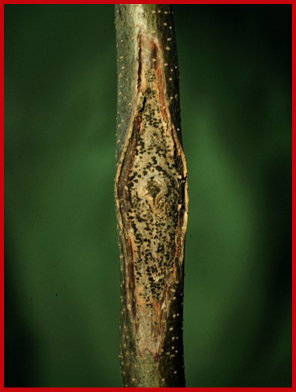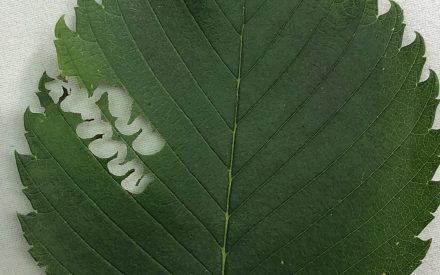
What is Thyronectria canker?
Thyronectria canker is a common fungal disease of honeylocust (Gleditsia triacanthos), occurring wherever this tree is grown. Black locust (Robinia pseudoacacia) and Kentucky coffeetree (Gymnocladus dioicus) have also been reported to be susceptible to the disease. Thyronectria canker is non-lethal and typically causes relatively minor damage to affected trees.
What does Thyronectria canker look like?
Thyronectria canker causes branch dieback. Affected branches are typically relatively small in diameter (approximately one inch or less), although larger branches can become infected. On smaller branches, distinct sunken areas (cankers) form at the point of infection. Within the sunken area, small dark-brown to black spots are typically visible.
Where does Thyronectria come from?
Thyronectria canker is caused by the fungus Thyronectria austoamericana (sometimes written Thyronectria austo-americana). The spots visible within the sunken areas on infected branches are clusters of fruiting bodies (i.e., reproductive structures) of the fungus. These structures produce multicelled, light- to medium-brown spores that, when released, can blow to susceptible trees, leading to new infections. Long periods of wet weather are favorable for infection to occur.
How do I save a tree with Thryronectria canker?
Remove infected branches by pruning four to six inches below obviously infected areas on branches. Be sure to prune only when it is dry, and be sure to disinfest pruning tools between cuts by treating them for at least 30 seconds with 70% alcohol (e.g., rubbing alcohol straight out of the bottle), spray disinfectants (as long as they contain 60 to 70% alcohol) or 10% bleach. If you use bleach, be sure to thoroughly rinse and oil tools after you are done pruning to prevent rusting. Dispose of branches by burning (where allowed) or burying them. Do not use fungicides for control of this disease.
How do I avoid problems with Thyronectria canker in the future?
Make sure your honeylocust tree is properly fertilized and watered to reduce stress and promote vigorous growth. Fertilize your honeylocust only if you have soil and foliage nutrient tests that indicate nutrient deficiencies that need to be corrected. The UW Soil and Forage Lab can assist with testing. An established honeylocust tree (i.e., a tree that has been planted for three or more years) requires approximately one inch of water per week from the time it buds out in the spring, through the summer and into the fall up until it starts to turn its normal fall color. When there is insufficient rain, water at the drip line of the tree (i.e., the edge of where the branches extend), or more extensively in the root zone if possible, using a drip or soaker hose. Remove grass out to the drip line of the tree, and mulch this area with a high quality mulch (e.g., shredded oak bark mulch, one of the cedar mulches). Use one to two inches of mulch if you have a heavier (e.g., clay) soil and three to four inches if you have a lighter (e.g., sandy) soil. Keep mulch four inches from the trunk of the tree. Finally, consider routine maintenance pruning by a certified arborist to thin the canopy of your honeylocust tree. Thinning will provide better airflow through the tree, promoting more rapid drying of branches and leaves, thus leading to a less favorable environment for infections to occur.
For more information on Thyronectria canker:
Contact the University of Wisconsin Plant Disease Diagnostics Clinic (PDDC) at (608) 262-2863 or pddc@wisc.edu.
Authors: Brian Hudelson, UW Plant Pathology
Last Revised: 03/02/2024
D-number: D0114
References to pesticide products in this publication are for your convenience and are not an endorsement or criticism of one product over similar products. You are responsible for using pesticides according to the manufacturer’s current label directions. Follow directions exactly to protect the environment and people from pesticide exposure. Failure to do so violates the law.
Thanks to Diana Alfuth, Bann Gabelt and Laura Jull for reviewing this document.
A complete inventory of UW Plant Disease Facts is available at the University of Wisconsin-Madison Plant Disease Diagnostics Clinic website: https://pddc.wisc.edu.
Send a Plant Sample for Analysis
Be cautious when self-diagnosing plant health issues. Very few diseases can accurately be diagnosed by eye.
Contact the UW Plant Disease Diagnostics Clinic (PDDC), and for a small fee, clinic staff can examine a plant, determine the cause of the disease/disorder, and provide advice on how to control or prevent the issue.
Download Article





 Silver Leaf
Silver Leaf Red Star Rust
Red Star Rust Tree Species Recommended for Fall Planting
Tree Species Recommended for Fall Planting Elm Zigzag Sawfly
Elm Zigzag Sawfly


